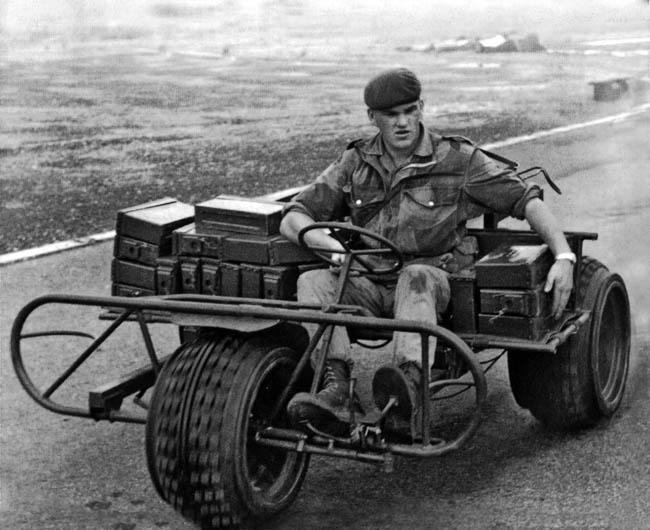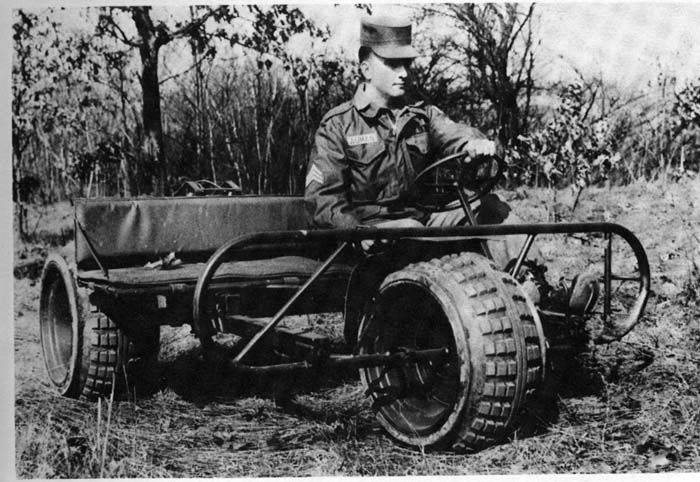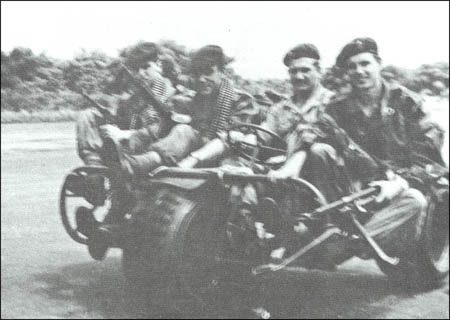FN AS 24 (1959)
 Motorized Tricycle (1959-1984) - 460 built
Motorized Tricycle (1959-1984) - 460 built
The Belgian Fabrique Nationale AS 24 was a Motorized utility Tricycle for transport, collapsible to be paradropped in airborne operations, used until 1983. It was to be dropped together with the paratroopers in airborne drops, and some 463 AS 24 were manufactured, plus at one or more prototypes. It was decommissioned starting in 1984 and up to 1990 at the latest. It's battle records included notably several operations in Congo (Zaire), notably Operation Dragon Rouge, a hostage rescue mission in Kisangani on Nov 24-27, 1964, where it proved intrumental.

Design Development
The use of paratroopers motivated in Europe and the US the search for an ultra-light, unarmoured vehicle that could take on the burden combat load for expeditions, under enemy lines, or just provide basic personal transportation. A small engine and a folding chassis would be able to be paradropped with eas from any dedicated aircraft, even legacy WW2 Douglas C47 Skytrain still fielded many nations in the 1950s. Belgium, which still possessed Congo at the time needed a light vehicle to provide basic transportation on the ground for its paratroopers often used in projection missions. In the US, this need was not limited to paratroopers but US Marines s well, and the US Army working in Vietnam or difficult terrain in general, and took the shape of the
M274 Mechanical mule
The "Mule" was studied in the early 1950s and manufactured from 1956 to 1970, with 11,240 provided as the M274 ½-ton 4×4 utility platform truck. It was a source of inspiration for man countries. Belgium was one of these, but looked at a very specific vehicle that can answer its needs, smaller than the M274. Instead of purchasing it, the Royal Army ordered it to the National Weapons Manufacturer, Fabrique Nationale (FN) based in Herstal, which proposed a prototype in 1959 later adopted as the Véhicule Aeroporte or Tricar Parachutable. FN had remarkable achievements to its credits, notably a modernization of the venerable Browning BAR which became the legendary FN Mag adopted throughout NATO ar large. The company also even had a go at several armoured vehicles.
Fabrique Nationale de Herstal originally was founded in 1889 in Wallonia (French speaking, southern part of the country) by Henri Pieper, starting right after the country's independence by licence manufacturing Mauser Model 89. Many billions of small arms later, FN Hestal became the largest exporter of military small arms in Europe by 2012. The company also manufacturers cars and motorcycle, so it's based on this know how that the company was able to develop a very small, very light, mostly folding tricycle usable to carry personal and material at a very basic level.
Enters Nicholas Straussler
It did not emerged from the blue however. The design was based on a development by Hungarian engineer Nicholas Straussler (behind the M4 Sherman floatable screen and many innovative prototypes among others). Indeed After the Second World War, Nicholas Straussler dealt with the issue of support for airborne troops. He started to design several concepts of easy to handle vehicles of very simple construction that could be dropped in one package from a C-47. Since Strausser lived in UK at that stage, not wishing to return in communist-held Hungary. He planned his idea for NATO paratroopers at large.
He created a first prototype in 1958-59. It was a barebones three-wheeled platform powered by a very small motorcycle engine, created at Waggon- und Maschinenbau GmbH Donauwörth (WMD). It had Lypsoid wheels coupled with low-pressure tires at 1.3 down to 0.5 bar in order to replace classic suspensions, and very good run-flat properties as a result. The tires were made in such a way the vehicle, even with its three tires flat, could still run c50 km.
The lypsoid wheel created by Straussler were produced by Metzeler in Munich, Germany. The entire tricycle was composed of articulated arms, which enabled a full folding into a package that could be pushed through the door of a C-47 in flight. But in that case, the landing as quite rough. The prototype had a two-cylinder British Anzani two-stroke in-line engine with a 322 cm³ displacement for 15 SAE horsepower (11 kW) coupled with a transmission was from Albion and had three forward gears and one reverse gear.
As a new aircraft entered service, the Nord Noratlas, used by France, Belgium, Austria and Germany, the latter had an opening rear fuselage cone, and large storage area making it easy to drop palletized loads; A new chassis had well though out attachement points that made it compatible with a pallet parachute. This pallet was 1.2 × 1.8 m, 500 kg payload, often completed with eight boxes of 7.62mm ammunition. It was specially developed for the vehicle, and padded with honeycomb paper, corrugated cardboard to cushion any rough landing.
Production by FN Herstal
After successful tests, FN in Belgium took over the license for its own serial production. Details of the knowledge of the system and adoption is not known but eventually only the Belgian Airborne Forces adopted the tricycle. Before series production began, the design was revised by FN. The tricycle was given the very reliable air-cooled B. Engine and gearbox from FN. Another change was the new FN designed front bar sloped towards the sides on the early serie in 1959, but slightly raised and straightened for the later 1960s series. FN tried to promote the vehicle and make it more flexible and modular for all sorts of military applications. It was soon marketed to other armies, and was eventually tested in the USA.
 US Army test in 1962.
US Army test in 1962.
But in the end, the original version remained, no changes were adopted for production, to the exception of single-axle trailer with the same tires as the AS 24. It was sized so that so that an entire tricycle folded could be carried on it. In addition, its wheels and suspensions were easy to remove. As nop customers of further application was found, FN Hestal ended production in 1963 after 463 of thes produced, the last delivered in 1966.
Design
The AS24 introduced in 1960 by FN was a low riding three-wheeler, capable of carrying several men and equipment after being dropped by parachute. Powered by a “Type 24 FN” engine the steering wheel was easily removable and attached to the rear of the vehicle. This means a person could walk behind and steer at the same time.
Its Engine was manufactured by FN 24 as a 2-cylinder in-line engine, two-stroke and displacing just 243.5 cm³ for 15 HP (11 kW) at 5300 rpm. It was air cooled, and there was no electrical system nor starter which was mechanical, by hand. It had though a multi-disc clutch in oil bath transmission with four forward sperds, no reverse, no suspensions, drum brakes on the rear wheels, a steering rack for a 3 x 2 configuration.
Its wheelbase was 1,270 mm, rear track 1,306 mm, turning circle 3.5 meters and when extended it could be 1,89 meters long for 1,64 meters wide and just 89 cm high. It looked like a simple bench with wheels. When packed, it was reduced to 1,065 meters same width and 75 cm high. Its tyres were special run flat, four-layer low-pressure Lypsoid models 22 x 12, so almost spherical. Curb weight of the vehicle was 224 kg and 564 kg max when fully loaded. The usual payload was up to 250 kg or the driver sat with three
more soldiers, all four on the bench which was the most usual configuration.
The "trike" as it was dubbed in U and the US had a towing capacity of 250 kg, and a gasoline tank capacity of 10.5 l for a top speed of 57 km/h on road and a range of 200 km empty, not bad for that small bugger. When fully loaded plus trailer off-road it fell down to a mere 50 km, which was believed to be sufficient fo its deployment range from the dropping zone. It was still capable of climbing a 60% gradient but was not amphibious (no buoyancy).
Variants
Various prototypes were created to try to improve the base model, one with a new engine, a weapon carrier with pintles to attach various weapon systems (like a Browning 0.3 MH, a grenade launcher or a recoiless rifle, as well as a sanitary vehicle to carry wounded personal. Tests were even done for a tracked chassis on the rear axle, with an additional smaller wheel in front of each rear wheel and chain with a flexible track, two control levers installed next to the steering column. It did not brought much to the table given the relative complication of the system compared to the base vehicle.
Operations

The tricycles remained in service with the Belgian army for quite some time. They were used in a wide variety of operations, most famously in "Operation Dragon Rouge" in Congo. Belgian paratroopers started to tests it in the first years, and do personnel training within the framework of various training events. Later on it saw its combat debuts in Congo by the early sixties, then in a booody civil war. In November 1964, the Simba rebels controlled Stanleyville and took hostage around 1800 white residents. Brussels confered with the US to provide C-130 Hercules as transports, and decided to sent all its airborne troops in what became operation "Red Dragon", srating with the seizure of Stanleyville airport.
The Belgian Paratroopers battalion ensured the arrival of reinforcements and heavy weapons and used a large number of different vehicles, but the first waves made forays into the city on tricycles FN AS 24. They were also used by amphibious troops for rapid personnel and weapons rinforcements in specified areas of the city under heavy fire. Operation Red Dragon ended on November 27 but was only a partial success. The paratroopers lost two (KiA) with 12 wounded but 24 hostage were killed, the remainder released and extracted to the airport. The "trike" proved all this time an invaluable asset but it was used mostly in urban combat.
From there, the FN AS 24 remained in the paratroopers inventiry for several more decades. By the late seventies the Belgian military department started to plan their replacement, whiuch was done gradually in all units until the late 1970s and early 1980s. Some of decommissioned tricycles were just BU, but others were sold from depots and surplus to the civilian market and still run today. One ended in the Brussels Army museum, others in private collections. Many are in working orders, being dumb simple to maintain and took part in reenacments in the region. They are often seen for example at Overloon. All in all, another interesting alternative to the "mechanical mule solution", perhaps even more austere. To this day there is no equivalent in NATO militaries.
specifications |
| Dimensions | 1890 x 1640 x 890mm |
| Wheelbase | 1270 mm |
| Track width rear | 1306 mm |
| Weight | 224 kg/564 kg max |
| Payload | 340 kg +250 kg towed |
| Crew | 3-4: driver, 2-3 seated either sides |
| Propulsion | FN 2-cyl. 2-str. 15 HP (11 kW) |
| Transmission | * |
| Top speed | 57 km/h Road |
| Fuel consumption | 10.5 l, Range 200 km (road) |
| Suspension | 3x2, Lypsoid 22x12 tires |
| Maximum range (on/off road) | km ( mi) |
| Armament | None |
| Production | c470 built |